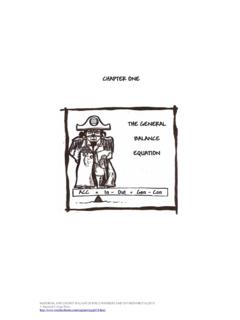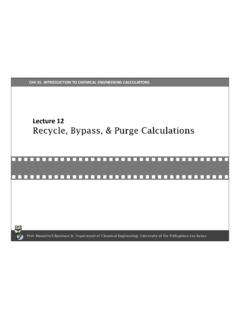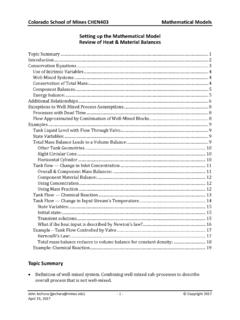Transcription of Materials and Energy Balance - Metalurji Ve Malzeme ...
1 Introduction Materials and Energy Balance covers the basic chemical principles that relate thermodynamics to chemical metallurgy The goal of a metallurgical engineer is to keep a metallurgical production process running as efficiently as possible Charge calculations, fuel calculations and estimation of the product yield are primary responsibilities that are based on stoichiometry and theoretical thermodynamic relations Basic principles of conservation of mass and Energy are utilized in this course to estimate important thermodynamic properties of Materials at equilibrium to a high degree of accuracy Thermodynamics Enthalpy, Free Energy Calculations Chemical Reaction Equilibria Materials and Energy Balance material Balance Stoichiometry Energy Balance Chemical Metallurgy Charge Calculations, Yield.
2 Efficiency Calculations Reaction Rate Metallurgical processes consist of many chemical reactions Stoichiometry calculations need to be done carefully for accurate estimation of what quantities of raw Materials convert to the desired quantity of products A metallurgical engineer has to know stoichiometry, mass Balance , enthalpy calculations, heat Balance , chemical reaction and anticipate what components of the charge convert to which products in order to have full control on a process Chemical Reaction Equilibria Heat Balance Mass Balance Stoichiometry Charge calculations Fuel calculations Efficiency calculations General Overlook to Chemical Metallurgy Metallurgy is the art of extracting metals from ores found concentrated in certain parts of the world, refining them and preparing for use Earth s crust is 35 km thick above molten iron.
3 Filled with metallic ores and other minerals On average the Earth s crust consists mostly of oxygen, silicon, aluminum and iron Ore minerals of common and precious metals Iron ores contain large amounts of the iron ore minerals and relatively small amounts of gangue Although ores as low as 25-30% Fe are smelted after concentration, most directly smelted ores contain about 50% Fe Hematite (Fe2O3) Most important ore mineral of iron Magnetite (Fe3O4) Magnetic mineral Limonite ( ) Not desirable due to low grade Siderite (FeCO3) Not desirable due to low grade Pyrite (FeS2) Used after roasting as iron oxide ash The only commercial aluminum ore is bauxite which is a rock consisting of hydrated oxides of aluminum with oxide ratio of 55-61% Al2O3, 10-30% combined water, 1-25% Fe2O3, 1-3% TiO2 and 1-12% SiO2 Gibbsite ( ) Diaspore ( ) Boehmite ( ) Corundum (Al2O3) Kaolinite ( ) The primary copper ore mineral is chalcopyrite Others are secondary minerals formed by the alteration of primary chalcopyrite and chalcocite CuS ores are usually associated with pyrite (FeS2)
4 And other base metal sulfides such as ZnS, PbS Copper minerals are usually associated with siliceous and other gangue minerals so that their grades are as low as 1-2% Cu Chalcopyrite (CuFeS2) Bornite (Cu5 FeS4) Chalcocite (Cu2S) Covellite (CuS) Enargite (CuAsS4) Malachite ( (OH)2) Cuprite (Cu2O) Chrysocolla ( ) Galena is the only important lead ore mineral Most lead ores are found in veins and not suitable for bulk mining The average grade of lead ore mined is higher than that of copper ore, around Pb Galena (PbS) Anglesite (PbSO4) Cerussite (PbCO3) Sphalerite (ZnS) is the only important zinc ore mineral and is associated with PbS, CuFeS2 or cadmium with an average grade around 2-12% Zn Smithsonite (ZnCO3) and calamine (Zn2(OH) occur in the oxidized portions of ore bodies Gold, silver and platinum most commonly occur in nature as native metals in metallic state but as alloys rather than pure metals Seldomly gold occurs as calaverite (AuTe2) and silver occurs as argentite (Ag2S), pyrargyrite (Ag3 SbS3) Gold, silver and platinum are usually associated with base-metal sulfides and pyrite Chromite ( ))
5 Is the only economical chromium ore mineral Commercial chromium ores usually contain at least 40% Cr2O3 Journey of Metal Oxide from Ore to Ingot Metal ore Mineral dressing Mechanical separation of the ore mineral grains from the gangue minerals to produce a concentrate Drying Removal of mechanically held water from concentrate in a high T or low P furnace Calcination Removal of chemically bound H2O or CO2 in a furnace at a higher T Roasting Converting metal sulfides partly or completely, into oxides that are more conveniently reduced to metals in a high temperature furnace Agglomeration Concentrates are reformed into agglomerates of appropriate size and strength to be used in a later treatment requiring coarse particles Pyrometallurgical, Hydrometallurgical.
6 Electrometallurgical Extraction Mineral Dressing Minerals must be liberated from their intimately associated gangue minerals before they can be collected in separate products The first part in mineral dressing is comminution which involves crushing and grinding of the ore to a point where each mineral grain is free Crushing (3 stages) Coarse crushing Ore rocks are reduced to 10 cm in a jaw or gyratory crusher Intermediate crushing Jaw, cone or roll crushers break ores from 10 cm to 1-2 cm Fine crushing Short head cone, roll crushers, hammer mills break ores from 1-2 cm to cm Grinding (2 stages)
7 Coarse grinding Ore feed as large as 50 mm are pulverized in rod mills to 300 microns Fine grinding Steel balls in ball mills reduce mm particles to less than 100 microns in wet environment The goals of comminution are 1- To obtain the correct degree of liberation of minerals 2- To increase the specific surface area of minerals for hydrometallurgical treatment Ore particles are continuously screened after crushing in a closed loop process Powder mineral mixtures are separated subsequently to two or more products according to their settling velocities in a suspending medium Particles above a certain size and density settle down while lighter ones are carried away Mineral Dressing The second part in mineral dressing is separation of the liberated valuable minerals from gangue minerals or concentration Physical concentration methods Separation dependent on optical or radioactive properties by hand picking, optical.
8 Radioactive sorting Separation dependent on density difference of minerals by sedimentation in heavy media Separation utilizing different surface properties of minerals by froth flotation Separation dependent on magnetic properties of minerals by dry and wet magnetic picking Separation dependent on electrical conductivity of minerals by electrostatic separation Separation is mostly done by physical means because they do not change the characteristics of the raw Materials Three end products of concentration are Concentrate Valuable minerals separated from ore Tailing Fraction of ore discarded as a valueless part Middlings Particles with valuable minerals and gangue locked together.
9 Further liberation needed by communition Drying Minerals recovered from ores are not in the optimum physical and chemical state for conversion to metals Drying is applied to moist concentrate powder to remove mechanically held water by evaporation Therefore the heat of evaporation must be supplied to the minerals in addition to the heat needed to elevate its temperature Energy intensive process Drying is usually done in a fixed or fluidized furnace or a kiln by passing hot combustion gases through the concentrate Calcination The chemically bound water, CO2 and other gases are removed from metal hydrate or carbonate particles by calcination The temperature required for complete calcination of a mineral is much higher than drying T Decomposition temperature ( temperature required for decomposition gas product pressure to reach 1 atm is different for each mineral FeCO3 T>200 C MnCO3 T>400 C CaCO3 T>900 C BaCO3 T>1000 C Al(OH))
10 3 T>1000 C Types of calcination furnaces Shaft furnace Calcining coarse particles Rotary kiln Particles of mixed coarse and fine size which disintegrate during the process Fluidized bed furnace Particles of uniform and fine size Roasting Oxides are more conveniently reduced to metals than sulfides or the metal might be more readily leached from the ore in sulfate, chloride or oxide form Roasting is chemical conversion of sulfides to an oxide or sulfate in an oxidized atmosphere in order to make them more soluble in acid Typical ores or concentrates which are roasted Cu, Fe, Zn, Pb 2 ZnS + 3 O2 = 2 ZnO + 2SO2 2 FeS2 + 11/2 O2 = Fe2O3 + 4SO2 2 PbS + 4O2 = 2 PbSO4 2 PbO + 2SO2 + O2 = 2 PbSO4 ZnO + Fe2O3 = ZnFe2O4 Metal sulfides are are partly or completely converted into metal oxides and SO2 forms Roasting temperatures should be higher than 500-600 C for the reduc









